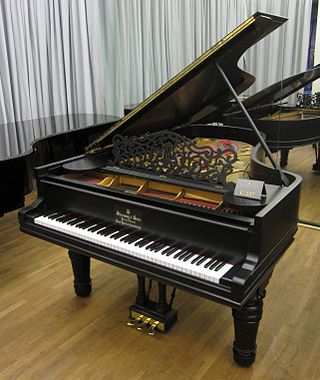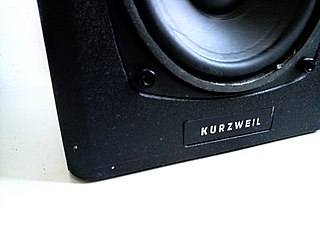
The piano is a keyboard instrument that produces sound when the keys are pressed. Most pianos have a row of 88 black and white keys: 52 white keys for the notes of the C major scale and 36 shorter and thinner black keys raised above the white keys and set further back, for sharps and flats. This means that the piano can play 88 different pitches, spanning a range of a bit over seven octaves. The black keys are for the "accidentals", which are needed to play in all twelve keys.

A digital piano is a type of electronic keyboard instrument designed to serve primarily as an alternative to the traditional acoustic piano, both in how it feels to play and in the sound it produces. Digital pianos use either synthesized emulation or recorded samples of an acoustic piano, which are played through one or more internal loudspeakers. They also incorporate weighted keys, which recreate the feel of an acoustic piano. Some digital pianos are designed to also look like an upright or grand piano. Others may be very simple, without a stand.

An electronic keyboard, portable keyboard, or digital keyboard is an electronic musical instrument based on keyboard instruments. Electronic keyboards include synthesizers, digital pianos, stage pianos, electronic organs and digital audio workstations. In technical terms, an electronic keyboard is a rompler-based synthesizer with a low-wattage power amplifier and small loudspeakers.
Piano construction is by now a rather conservative area; most of the technological advances were made by about 1900, and indeed it is possible that some contemporary piano buyers might actually be suspicious of pianos that are made differently from the older kind. Yet piano manufacturers, especially the smaller ones, are still experimenting with ways to build better pianos.
Keytar is a keyboard instrument similar to a synthesizer or MIDI controller that is supported by a strap around the neck and shoulders, similar to the way a guitar is held.

Kurzweil Music Systems is an American company that produces electronic musical instruments. It was founded in 1982 by Stevie Wonder (musician), Ray Kurzweil (innovator) and Bruce Cichowlas.

Piano tuning is the act of adjusting the tension of the strings of an acoustic piano so that the musical intervals between strings are in tune. The meaning of the term 'in tune', in the context of piano tuning, is not simply a particular fixed set of pitches. Fine piano tuning requires an assessment of the vibration interaction among notes, which is different for every piano, thus in practice requiring slightly different pitches from any theoretical standard. Pianos are usually tuned to a modified version of the system called equal temperament.

A MIDI controller is any hardware or software that generates and transmits Musical Instrument Digital Interface (MIDI) data to MIDI-enabled devices, typically to trigger sounds and control parameters of an electronic music performance. They most often use a musical keyboard to send data about the pitch of notes to play, although a MIDI controller may trigger lighting and other effects. A wind controller has a sensor that converts breath pressure to volume information and lip pressure to control pitch. Controllers for percussion and stringed instruments exist, as well as specialized and experimental devices. Some MIDI controllers are used in association with specific digital audio workstation software. The original MIDI specification has been extended to include a greater range of control features.

Electronic drums are a modern electronic musical instrument, primarily designed to serve as an alternative to an acoustic drum kit. Electronic drums consist of an electronic sound module which produces the synthesized or sampled percussion sounds and a set of pads, usually constructed in a shape to resemble drums and cymbals, which are equipped with electronic sensors to send an electronic signal to the sound module which outputs a sound. Like acoustic drums, the pads are struck by drum sticks and they are played in a similar manner to an acoustic drum kit, albeit with some differences in the drumming experience.
Keyboard expression is the ability of a keyboard musical instrument to change tone or other qualities of the sound in response to velocity, pressure or other variations in how the performer depresses the keys of the musical keyboard. Expression types include:

A stage piano is an electronic musical instrument designed for use in live performances on stage or in a studio, as well as for music recording in Jazz and popular music. While stage pianos share some of the same features as digital pianos designed for home use and synthesizers, they have a number of features which set them apart. Stage pianos usually provide a smaller number of sounds, with these being of higher quality than the ones found on regular digital pianos and home synthesizers.

A MIDI keyboard or controller keyboard is typically a piano-style electronic musical keyboard, often with other buttons, wheels and sliders, used as a MIDI controller for sending Musical Instrument Digital Interface (MIDI) commands over a USB or MIDI 5-pin cable to other musical devices or computers. MIDI keyboards lacking an onboard sound module cannot produce sounds themselves, however some models of MIDI keyboards contain both a MIDI controller and sound module.

The Yamaha Motif is a series of music workstation synthesizers, first released by Yamaha Corporation in August 2001. The Motif replaced the EX series in Yamaha's line-up and was also based on the early Yamaha S series. Other workstations in the same class are the Korg Kronos and the Roland Fantom G. The series' successor is Yamaha Montage, released in 2016, followed up by the Yamaha Montage M in 2023.

A Zendrum is a hand-crafted MIDI controller that is used as a percussion instrument. The Zendrum was influenced by the "Drumitar," invented by Future Man. There are several Zendrum models that are well-suited for live performances: the Z1, ZX, EXP, ZAP series, LT and the Mallet Pro series and Melodic Finger. The Zendrum ZX and Z1 can be worn like a guitar and consists of a triangular hardwood body with 24 touch-sensitive round MIDI triggers. The EXP has 29 triggers and additional controls. The Zendrum LT can also be worn with a guitar strap, and has 25 MIDI triggers in a symmetrical layout, which provides an ambidextrous playing surface. The ZAP series is designed more for table top use or on a drum stand, with the ZAP1 having 19 triggers, and the ZAP2 having 25 triggers. The triggers are played by tapping or slapping with the fingers or hands. As a controller, the Zendrum does not make any sound by itself. It uses an electronic interface called MIDI to control synthesizers, samplers, drum machines, sound modules, computers or other electronic drum devices that generates the musical and percussive sounds. The Mallet Pro Series is laid out and played like a traditional mallet instrument, like a marimba. The Mallet Pro series has naturally resonating solid walnut bars as triggers.

A wind controller, sometimes referred to as a wind synthesizer, is an electronic wind instrument. It is usually a MIDI controller associated with one or more music synthesizers. Wind controllers are most commonly played and fingered like a woodwind instrument, usually the saxophone, with the next most common being brass fingering, particularly the trumpet. Models have been produced that play and finger like other acoustic instruments such as the recorder or the tin whistle. The most common form of wind controller uses electronic sensors to convert fingering, breath pressure, bite pressure, finger pressure, and other gesture or action information into control signals that affect musical sounds. The control signals or MIDI messages generated by the wind controller are used to control internal or external devices such as analog synthesizers or MIDI-compatible synthesizers, synth modules, softsynths, sequencers, or even non-instruments such as lighting systems.
The Nord Stage is a digital keyboard or stage piano, manufactured by Clavia Digital Music Instruments of Stockholm, Sweden. There have been six editions of the instrument: the original Nord Stage in 2005, the Nord Stage EX in 2008, the Nord Stage 2 in 2011, the Nord Stage 2 EX in 2015, the Nord Stage 3 in 2017, and the Nord Stage 4 in 2023.
The piano action mechanism of a piano or other musical keyboard is the mechanical assembly which translates the depression of the keys into rapid motion of a hammer, which creates sound by striking the strings. Action can refer to that of a piano or other musical keyboards, including the electronic or digital stage piano and synthesizer, on which some models have "weighted keys", which simulate the touch and feel of an acoustic piano. The design of the key action mechanism determines the "weighted keys" feeling; that is, the feeling of the heaviness of the touch of the keys."A professional pianist is likely to care most about the piano's action, because that is what controls its responsiveness and relative lightness--or heaviness--of touch. Roughly speaking, a piano's action is light when its keys fall easily under the fingers, and heavy when a noticeable downward thrust is required. The action, in short, is what makes a piano playable or not to an individual musician."

A guitar synthesizer is any one of a number of musical instrument systems that allow a guitarist to access synthesizer capabilities.

Disklavier is a brand of reproducing pianos manufactured by Yamaha Corporation. The first Disklavier was introduced in the United States in 1987.

A digital accordion is an electronic musical instrument that uses the control features of a traditional accordion to trigger a digital sound module that produces synthesized or digitally sampled accordion sounds or, in most instruments, a range of non-accordion sounds, such as orchestral instruments, pipe organ, piano, guitar, and so on. Digital accordions typically encode and transmit key presses and other input as Musical Instrument Digital Interface (MIDI) messages. Most digital accordions need to be plugged into a keyboard amplifier or PA system to hear their sounds.














